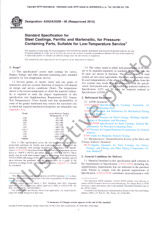We need your consent to use the individual data so that you can see information about your interests, among other things. Click "OK" to give your consent.
ASTM E2948-22
Standard Test Method for Conducting Rotating Bending Fatigue Tests of Solid Round Fine Wire
Translate name
STANDARD published on 1.2.2022
The information about the standard:
Designation standards: ASTM E2948-22
Note: WITHDRAWN
Publication date standards: 1.2.2022
SKU: NS-1050734
The number of pages: 10
Approximate weight : 30 g (0.07 lbs)
Country: American technical standard
Category: Technical standards ASTM
The category - similar standards:
Annotation of standard text ASTM E2948-22 :
Keywords:
fatigue, rotating bending, wire,, ICS Number Code 77.140.65 (Steel wire, wir ropes and link chains)
Additional information
| Significance and Use | ||||||||||||||
|
5.1?A method for obtaining fatigue strain (stress) at a specific life is of interest to the wire manufacturer, designer and consumer. The method is useful in production control, material acceptance and determination of the fatigue strain (stress) of the wire at a specific fatigue life, that is, fatigue strength. Rotating bending fatigue testing of small diameter solid round wire is possible by looping a specimen of predetermined length through an arc of 90? to 180?. The bending strain (stress) is determined from the geometry of the loop thusly formed. The methodology is capable of high frequency testing provided the temperature of the test article is constant and there is no adiabatic heating of the wire. A constant temperature can be maintained by immersing the specimen in a constant temperature fluid bath or test media. This makes it practical to quickly test a sufficient number of specimens to provide a statistical frequency distribution or survival probability distribution of fatigue life at a given strain (stress). Fatigue life information is useful to ascertain wire in-service durability and to assess, for example, the effects of melt practice and cold work processing. |
||||||||||||||
| 1. Scope | ||||||||||||||
|
1.1?This
test method is intended as a procedure for the performance of
rotating bending fatigue tests of solid round fine wire to obtain
the fatigue strength of metallic materials at a specified life in
the fatigue regime where the strains (stresses) are predominately
and nominally linear elastic. This test method is limited to the
fatigue testing of small diameter solid round wire subjected to a
constant amplitude periodic strain (stress). The methodology can be
useful in assessing the effects of internal material structure,
such as inclusions, in melt technique and cold work processing
studies. However, there is a caveat. The strain, due to the radial
strain gradient imposed by the test methodology, is a maximum at
the surface and zero at the centerline. Thus the test method may
not seek out the weakest link, largest inclusions, that govern
uniaxial high cycle fatigue life where the strain is uniform across
the cross section and where fatigue damage initiates at a
subsurface location Note 1:?The following documents, although not specifically
mentioned, are considered sufficiently important to be listed in
this test method: 1.3?This international standard was developed in accordance with internationally recognized principles on standardization established in the Decision on Principles for the Development of International Standards, Guides and Recommendations issued by the World Trade Organization Technical Barriers to Trade (TBT) Committee. |
||||||||||||||
| 2. Referenced Documents | ||||||||||||||
|
We recommend:
Technical standards updating
Do you want to make sure you use only the valid technical standards?
We can offer you a solution which will provide you a monthly overview concerning the updating of standards which you use.
Would you like to know more? Look at this page.




 Cookies
Cookies
